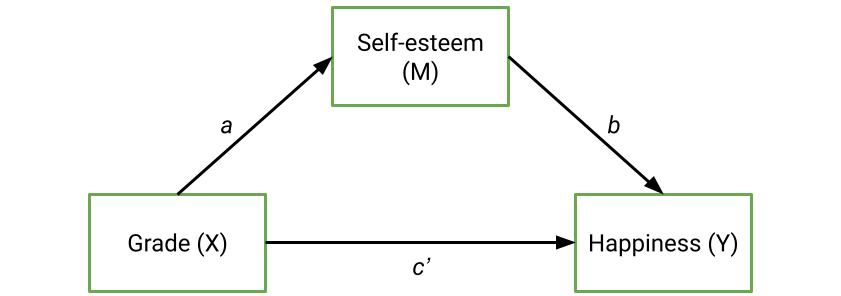13.2 Mediation: Causal steps
No introduction to mediation is complete without considering the causal steps approach, which held dominance as the main method of testing mediations for a while. Below is an overview of this approach.
13.2.1 The causal steps approach
The causal steps approach outlined by Baron and Kenny (1986) was one of the first defined ways to test for a mediation. The name refers to a sequence of analytical steps that must be taken in order to apparently demonstrate a mediation, in line with the figure we saw on the previous page:
To illustrate the causal steps approach (and subsequent approaches), we will use a fictional dataset below. This dataset contains scores on students’ grades, self-esteem and happiness. We theorise that the relationship between a student’s grades and their happiness is mediated by their self-esteem, which gives rise to the hypothetical mediation below:

13.2.2 Step 1: Test the direct effect (c)
The first step in the classic causal steps approach is simply to see whether our predictor X predicts the outcome Y, using a linear regression. This tests the direct effect, c. The magnitude of this direct effect is 0.396.
##
## Call:
## lm(formula = happiness ~ grade, data = med_data)
##
## Residuals:
## Min 1Q Median 3Q Max
## -5.0262 -1.2340 -0.3282 1.5583 5.1622
##
## Coefficients:
## Estimate Std. Error t value Pr(>|t|)
## (Intercept) 2.8572 0.6932 4.122 7.88e-05 ***
## grade 0.3961 0.1112 3.564 0.000567 ***
## ---
## Signif. codes: 0 '***' 0.001 '**' 0.01 '*' 0.05 '.' 0.1 ' ' 1
##
## Residual standard error: 1.929 on 98 degrees of freedom
## Multiple R-squared: 0.1147, Adjusted R-squared: 0.1057
## F-statistic: 12.7 on 1 and 98 DF, p-value: 0.000567113.2.3 Step 2: Test the predictor and mediator (a)
The next step is to see whether the predictor significantly predicts the mediator, which denotes the a path. The estimate for a in this case is 0.561.
##
## Call:
## lm(formula = self_esteem ~ grade, data = med_data)
##
## Residuals:
## Min 1Q Median 3Q Max
## -4.3046 -0.8656 0.1344 1.1344 4.6954
##
## Coefficients:
## Estimate Std. Error t value Pr(>|t|)
## (Intercept) 1.49952 0.58920 2.545 0.0125 *
## grade 0.56102 0.09448 5.938 4.39e-08 ***
## ---
## Signif. codes: 0 '***' 0.001 '**' 0.01 '*' 0.05 '.' 0.1 ' ' 1
##
## Residual standard error: 1.639 on 98 degrees of freedom
## Multiple R-squared: 0.2646, Adjusted R-squared: 0.2571
## F-statistic: 35.26 on 1 and 98 DF, p-value: 4.391e-0813.2.4 Step 3: Test the predictor and mediator on the outcome (b)
This step involves running a multiple regression with both X and M as predictors, and Y as the outcome. This is because as in the model above, the effect of Y is determined by both the effect of the predictor and the mediator. The estimate for b is the regression coefficient for the mediator in this analysis - in this case, b = 0.6355.
##
## Call:
## lm(formula = happiness ~ grade + self_esteem, data = med_data)
##
## Residuals:
## Min 1Q Median 3Q Max
## -3.7631 -1.2393 0.0308 1.0832 4.0055
##
## Coefficients:
## Estimate Std. Error t value Pr(>|t|)
## (Intercept) 1.9043 0.6055 3.145 0.0022 **
## grade 0.0396 0.1096 0.361 0.7187
## self_esteem 0.6355 0.1005 6.321 7.92e-09 ***
## ---
## Signif. codes: 0 '***' 0.001 '**' 0.01 '*' 0.05 '.' 0.1 ' ' 1
##
## Residual standard error: 1.631 on 97 degrees of freedom
## Multiple R-squared: 0.373, Adjusted R-squared: 0.3601
## F-statistic: 28.85 on 2 and 97 DF, p-value: 1.471e-1013.2.5 Step 4: Decide the extent of mediation
Recall on the previous page that the idea of mediation is to see how close c, the direct effect, gets to zero after mediation (i.e. c’ = 0). The significance of the mediated direct effect, c’, as well as its magnitude are generally used to determine the extent to which this direct effect has been mediated.
If full mediation has occurred, the effect of c’ should be non-significant and close to 0. If c’ is still significant and not close to 0, but all the other steps are significant, then partial mediation is said to have occurred.
In our instance, the estimate of c’ is 0.0396, with a p-value of .719. Given that the c’ effect is non-significant, we would say that self-esteem fully mediates the relationship between grades and happiness.
One final check - also recall that the total effect, c, can be broken down into the direct effect c’ and the indirect effect ab. You can manually check the maths here - ab (0.561 * 0.6355) + 0.0396 (the coefficient for c’) gives us 0.396, which was our initial estimate of the total effect c.
13.2.6 Problems with the causal steps approach
The causal steps approach is not often used in mediation analyses anymore for a couple of reasons:
- Step 1 is not always necessary. A non-significant c does not necessarily indicate that there is no mediation - in fact, sometimes we can observe suppression effects, where the indirect effect is positive while the direct effect is negative (or vice versa). This can happen when the causal chains act in opposite directions, thereby cancelling out the overall effect.
- This approach does not really test the indirect path - only its individual components. Because we are interested in the effect of the mediating path, i.e. ab, it makes sense that we would want to know if that overall indirect effect is significant. However, this approach doesn’t actually test for that.
- Related to the above, Type II errors can be higher with this approach - some mediation effects can be missed.